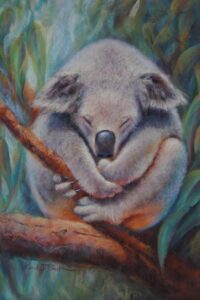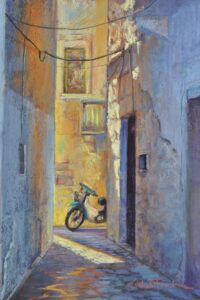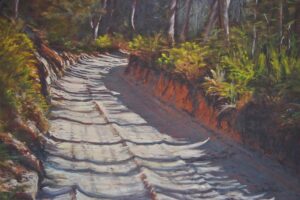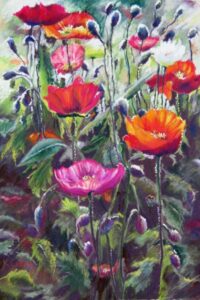Painting isn’t just about using different mediums to create a piece of art. A painting is capable of evoking emotions and telling a story in a unique and interesting manner. Like many other art forms, pastel painting is a means of drawing an subject while incorporating layers of colour and other resources. So how do you create a pastel painting that leaves a long-lasting impression on art admirers?
Unlike many other painting forms, pastel paintings are made using sticks of pigment. Before you start a pastel painting, it is necessary to understand something about pastels themselves and any other mediums that you may use.

What Are Pastels? What Types Are There?
Pastels are pigment sticks that an artist uses in place of acrylics, oils, water-colours and other colour options. The pigment itself is held together with different types of binders. There are a number of different types of pastels that artists can use depending upon their own requirements and the images they wish to create. They are:
I. Soft Pastels
II. Hard Pastels
III. Pastel Pencils
IV. Oil Pastels
Soft pastels are the most commonly used pastels worldwide. They have a high concentration of pigment and contain the least amount of binder. Conversely, hard pastels contain less pigment and more binder than soft pastels.
Pastel pencils look like ordinary pencils but they come with many benefits for artists. While using pastel pencils, artists can exercise greater control over an artwork. They allow an artist to create a more precise and defined image, while oil pastel pencils in particular help to bring increased texture and versatility to a painting.

Other Pastel Painting Mediums
Apart from pastels, there are several other elements that an artist may source when creating a painting.
I. Pastel Papers: Paper is as important as the pastels themselves. Pastel paper is the surface upon which an artist draws his or her subject. The surface of the paper itself will vary and it should be sourced from a reputable supplier and chosen carefully.
II. Drawing Board: To create a beautiful painting, you will require a drawing board or easel.
III. Tape: Tape is required to attach the paper surface firmly and effectively onto the board or easel.
IV. Fixative: The use of a spray on fixative is often a good idea to protect pastel layers from being smudged.
Painting With Pastels: Get Started
Once you have decided on a type of pastel to use and collected all of the necessary elements, you can take your first step towards painting with pastels.
Here are five simple steps to get started:
Step 1: Create A Rough Sketch
Before starting a pastel painting, you should create a rough sketch of your subject. Outline the borders and create an outline. Play around with some of the colours that you intend using to see how they might blend together.
Step 2: Create Shapes and a Base Of Colours
Practice on a rough sheet of paper before presenting the shape of your subject on the original paper. Once you have created an outline, you can start to apply a base of colours. As these first few layers of colour won’t necessarily appear on the surface of the final image, you can apply them reasonably quickly without paying too much attention to detail.
Step 3: Make Layers Of Colour
Layering is an important aspect of pastel painting. In fact, the real work begins when you start making layers of pastel colours. Start with simple strokes and follow a layer-by-layer approach. Later you can make time to fill in colours and shapes to ensure they resemble the original object or the image you are trying to create.
Step 4: Pay Attention To Fine Details
To match your painting with the subject in mind, you need to pay the attention to the finer details. While following this step, you need to be patient and try giving your painting a visual clarity. You can always keep working on the painting until you feel it’s complete. To achieve some fine details, you can make use of sharp edges of your pastels or a pencil.
Step 5: Remove The Unwanted Dust
Although it is the final step to painting with pastels, you should never be in hurry. Here, you need to remove the unwanted dust without ruining the painting. To do so, you should hold the paper carefully and gently tap on the surface.
Final Words
You have learned some important things about pastel art and how to paint with pastels. It’s now time to put this into practice. Collect all the sources of information that you can and create a wonderful pastel painting.



